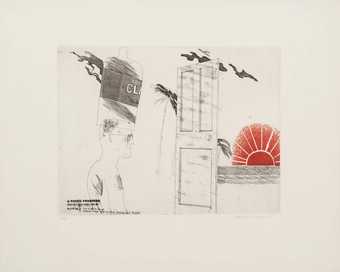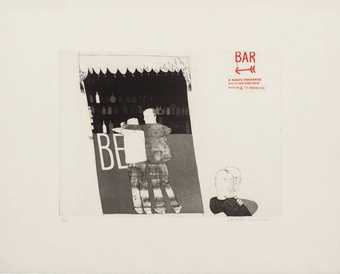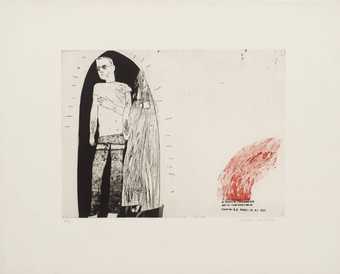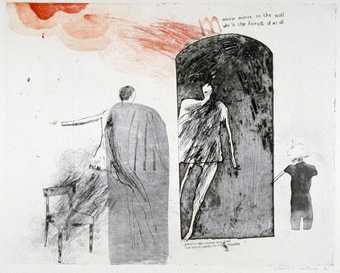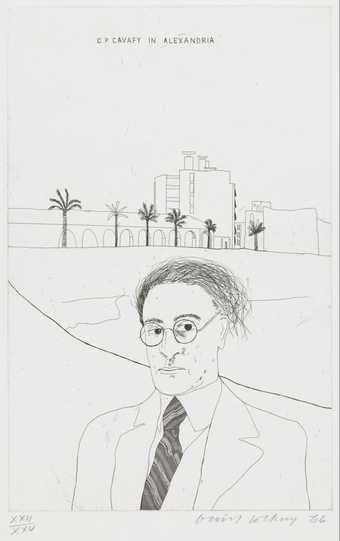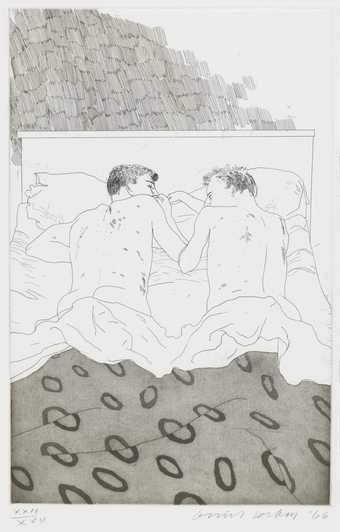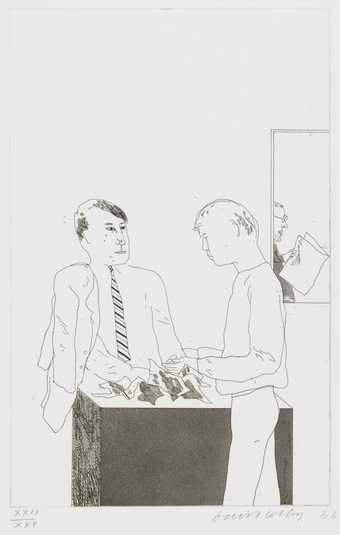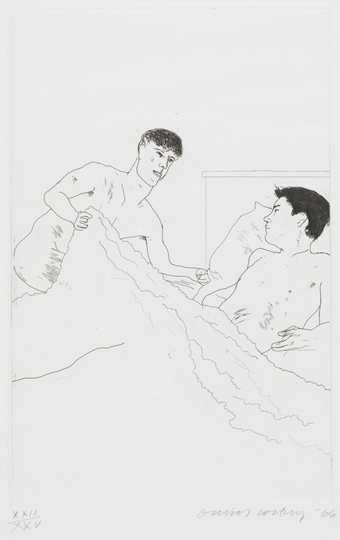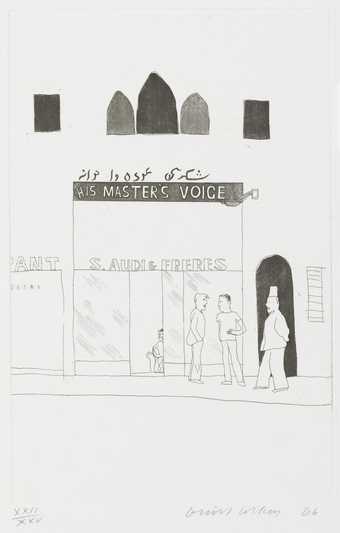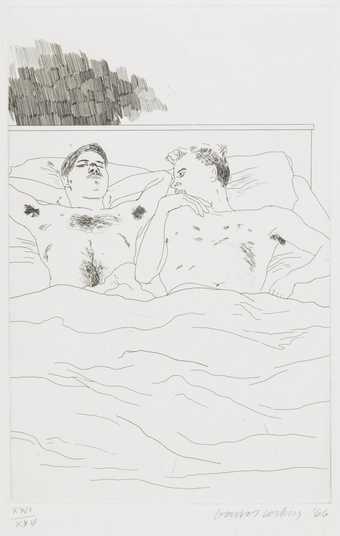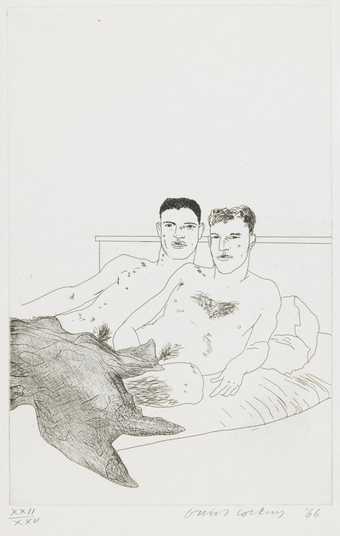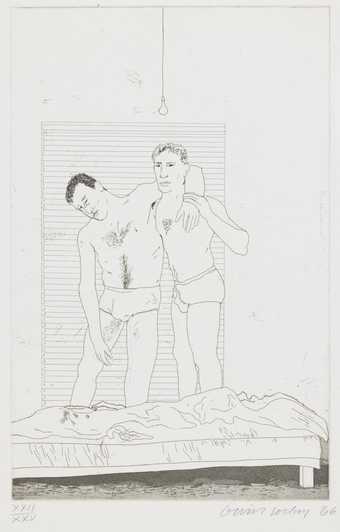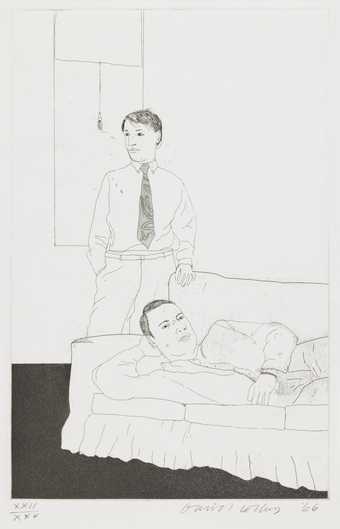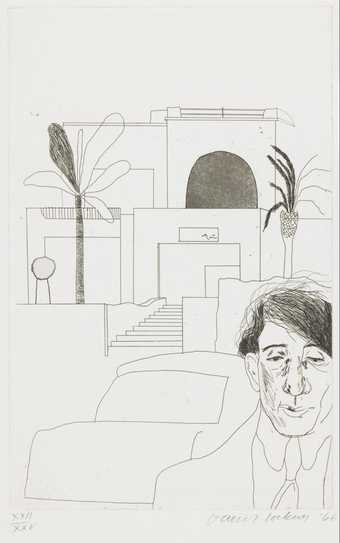
Not on display
- Artist
- David Hockney born 1937
- Medium
- Etching and aquatint on paper
- Dimensions
- Image: 345 × 223 mm
- Collection
- Tate
- Acquisition
- Purchased 1992
- Reference
- P77566
Summary
This is one of thirteen etchings for Illustrations for Fourteen Poems from C.P. Cavafy, (Tate Gallery P77563-77575). Hockney's first major series of etchings since A Rake's Progress (1961-3), it was conceived almost entirely in terms of line, and contained some of the artist's most accomplished line drawings to that date. He had made earlier references to the writings of the pre-war Greek poet Constantine P. Cavafy. Mirror, Mirror on the Wall, 1961 (Tate Gallery P11377), contains a quotation from the last two lines of the poem 'The Mirror in the Hall', and A Grand Procession of Dignitaries in the Semi-Egyptian Style, 1961 (private collection) was inspired by the poem 'Waiting for the Barbarians'. But this was Hockney's first major statement inspired by the poet. Although he originally intended to illustrate a far more ambitious range of poems, this proved impractical and he therefore decided only to include those on the subject of homosexual love. A new translation was produced by the poets Stephen Spender and Nikos Stangos, and published with the etchings in 1967.
In early 1966 Hockney went to Beirut, which he saw as the contemporary equivalent of Cavafy's Alexandria, to research imagery for the prints. While taking inspiration from Cavafy's poetry, Hockney also drew upon his own experiences and environment. For instance, his ink drawing Boys in Bed, Beirut (1966) (in fact drawn in London using two of his friends as models) was adapted for one of the prints, According to Prescriptions of Ancient Magicians. Photographs were also used as reference material, especially for such prints as In an Old Book and The Beginning, and the portraits of Cavafy - images he describes as 'very posed' (Livingstone, p.86). Hockney was not entirely pleased with the results, however: 'Things like weight and volume are very hard to get from a photograph. You don't get the information you need to be able to do the line' (Livingstone, pp.87-8).
Hockney conceived the images, like the English texts, as an updated translation of Cavafy's imagery. Portrait of Cavafy II depicts the poet in front of an architectural setting copied from a drawing Hockney made of a Beirut police station, with a modern car in the foreground. Only a few of the etchings (He Enquired After the Quality, The Shop Window of a Tobacco Store) depict a particular place or scene as described in the poems. Hockney did not work with the poems at his side, nor did he intend each image to be an illustration of a particular poem. Rather, he and Stangos assigned poems to the etchings only after the prints were done. Intended as visual equivalents to the mood and theme of all Cavafy's homoerotic poetry, Hockney's etchings depict variations on the theme of two men engaged in endless, anonymous pick-ups. Certain themes are found in the work of both Hockney and Cavafy: fleeting experiences, a nostalgia for the erotic, and a desire to be deeply involved in the lives of others while remaining a detached spectator.
Further reading:
Nikos Stangos (ed.), David Hockney by David Hockney, London 1976, pp.14, 102, reproduced pp.137-9
Marco
Livingstone, David Hockney, revised edition, London 1987, pp.85-89 (reproduced)
Marco Livingstone, David Hockney: Etchings and Lithographs, exhibition catalogue, Waddington Graphics, London 1988, introduction [pp.10-11], reproduced
pls.16-19
Terry Riggs
November 1997
Does this text contain inaccurate information or language that you feel we should improve or change? We would like to hear from you.
Display caption
Hockney creates scenes of touching intimacy in these simple etchings depicting gay love. They were made to illustrate a series of erotic poems by the Greek-Egyptian writer C. P. Cavafy. Hockney greatly admired Cavafy’s ability to write openly and unapologetically about gay relationships. Many of Hockney’s illustrations are based on intimate sketches of his friends. Others were drawn from photographs. The backgrounds are based on a trip Hockney took to Beirut, Lebanon in 1966. He felt that Beirut’s cosmopolitan atmosphere made it the contemporary equivalent of Cavafy’s native Alexandria, Egypt.
Gallery label, July 2021
Does this text contain inaccurate information or language that you feel we should improve or change? We would like to hear from you.
Explore
- architecture(30,960)
- public and municipal(2,385)
-
- shop(399)
- townscapes / man-made features(21,603)
-
- signage(467)
- clothing and personal items(5,879)
-
- jacket(209)
- countries and continents(17,390)
-
- Egypt(98)
- Alexandria(5)
- sex and relationships(833)
-
- homosexuality(1,673)
- sex(557)
You might like
-
David Hockney 3. The Start of the Spending Spree and the Door Opening for a Blonde
1961–3 -
David Hockney 4. The Drinking Scene
1961–3 -
David Hockney 4a. Marries an Old Maid
1961–3 -
David Hockney Mirror, Mirror on the Wall
1961 -
David Hockney Portrait of Cavafy in Alexandria
1966 -
David Hockney Two Boys Aged 23 or 24
1966 -
David Hockney He Enquired After the Quality
1966 -
David Hockney According to Prescriptions of Ancient Magicians
1966 -
David Hockney The Shop Window of a Tobacco Store
1966 -
David Hockney In the Dull Village
1966 -
David Hockney The Beginning
1966 -
David Hockney One Night
1966 -
David Hockney In Despair
1966 -
David Hockney Beautiful and White Flowers
1966 -
David Hockney Portrait of Cavafy II
1966

